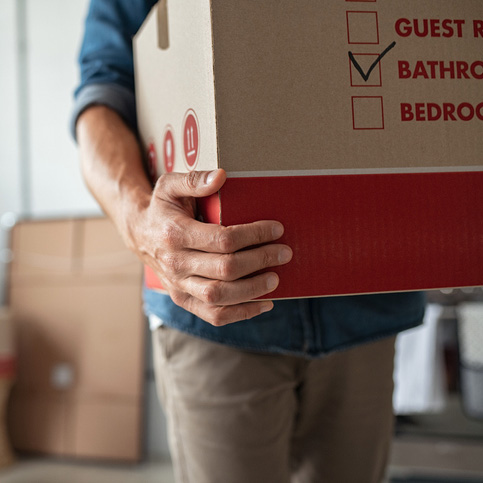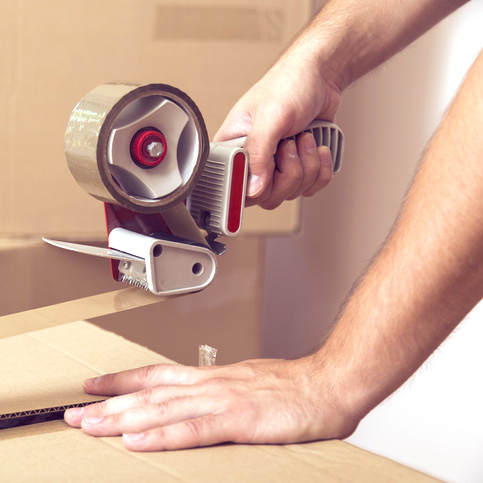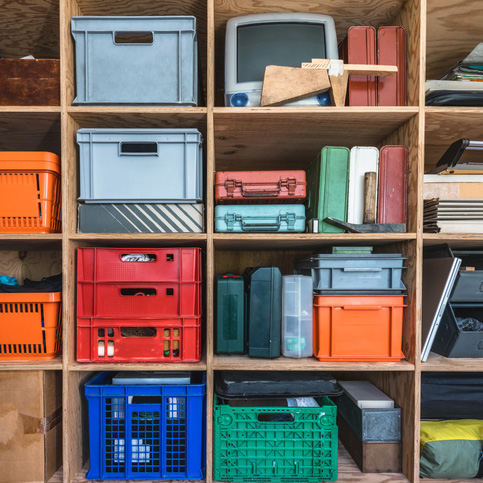
11 Tips for Combining Households
Be it for love, out of necessity, or somewhere in between, the need to combine households can happen to homeowners and renters at almost any age or stage of life.
The Benefits of Climate Controlled Storage
Everything You Need to Know about Storage Units
How to Move Without a Job
Drive-up Storage, The Original Self Storage Solution
New Year's Resolutions Template for an Epic 2024!
11 Home Addition Ideas to Increase Living Space
7 Most-Asked Questions About Self-Storage
7 Interior Design Trends that Need Storage
5 Things to Organize in Your Home: Get Started Organizing
What to Bring Camping: Download our Free Camping Essentials Checklist
The Most Dog-Friendly Cities in the United States (Store Space Edition)
How to Plan for a Garage Sale: 5 Steps to a Successful Garage Sale
She-Shed Vs. Man Cave: What's the difference?
How to Declutter and Organize Your Bathroom: 11 Tips You Can't Miss
How to Incorporate Hygge in Your Home: 11 Tips for Hygge
9 Things to Know Before Moving to Tampa
How to Organize and Declutter Your Kitchen: Your Kitchen Never Looked so Good
How to Upgrade Your Home This Year: 11 Ideas for Your Next Home Improvement Project
How to Declutter and Organize Your Bedroom
10 Things We Like About Texas
How to Declutter and Organize a Garage
5 Things to Remember when Moving and Packing
It’s OK to Have Stuff
The Best Move-in Checklist for Couples
5 Simple Steps to Start Becoming a Minimalist Today
How to Winterize Your Camper: Checklist and PDF
5 Places to Declutter Before Christmas: Make Room for a Festive Holiday Season
Is Fairview, NJ, a Good Place to Live? Pros & Cons
Is Hillsborough, NJ, a Good Place to Live?
How to Turn Your Home into an Amazing Vacation Rental
Is Glen Cove, NY, a Good Place to Live? Pros and Cons
The Best Storage Hacks: Tips and Tricks to Declutter and Organize Your Home
Is South Elgin a Good Place to Live?
How to Store Belts: 6 Tips to Keep Your Belts in Great Shape
18 Critical Things to do Before Selling Your House + Checklist
Is Providence a Good Place to Live? Moving to Rhode Island
13 Genius Dorm Storage Ideas
Condo Living: Is Downsizing to a Condo Worth it?
Is Central Falls a Good Place to Live? Pros & Cons
Is Macon, GA a Good Place to Live?
Is Greenwood, SC, a Good Place to Live? Pros & Cons
7 Strategic Hacks for Decorating a Studio Apartment on a Budget
6 Best Places to Live in St. Louis
Is Bonita Springs a Good Place to Live? Moving to Florida’s Gulf Coast
Is Syracuse a Good Place to Live?
15 Important Tips You Need to Know Before Living Alone for the First Time
22 Essential Moving Tips and Tricks for Packing Day
How to Properly Store & Organize Swimsuits
What we Like About Northside: An Eclectic, Diverse Cincinnati Neighborhood
5 Terrific Tailored Tips for Storing Suits
How to Store Shoes: 11 Genius Tips
How to Store the Most Popular Collectibles Properly: From A to Z
8 Expert Luggage and Suitcase Storage Tips
The Best Way to Pack Christmas Ornaments
How to Organize Your Basement: A Complete Guide in 7 Ingenious Steps
6 Reasons Why Cape Coral, FL is a Good Place to Live
7 Genius Tips for Storing Paper Like Michael Scott
Is Brandon a Good Place to Live? Moving to Florida
8 Important Pros and Cons of Living in Jacksonville, FL
Your 4 Summer Self Storage Tips to Make Memorial Day Memorable
5 Reasons Why Totowa NJ is a Good Place to Live
Do I Need Climate-Controlled Storage? 50 Items That Need Climate Control
Is Orlando a Good Place to Live?
Is Gainesville a Good Place to Live? Moving to Florida
Is Dallas a Good Place to Live? Pros & Cons
11 Unexpected & Hidden Costs of Moving You Don't Want to Forget
How to Maximize Small Closet Space in 10 Easy Steps
How to Properly Store & Organize Your Hat Collection
Is Sugar Land, TX, a Good Place to Live? Pros & Cons
How to Properly Store Stuffed Animals For Long-Term Storage
Is Humble TX a Good Place to Live? Pros & Cons + Poll
21 Surefire Tips to Stage Your House on a Budget & Close the Deal
How to Store a Mattress Topper in 4 Steps
6 Golden Rules for Packing for Long-Term Storage
The Correct Way to Move and Store a Sleep Number Mattress
The Best Way to Store Printed Photos Long-Term: Preserve Photographs for Generations
Spring Cleaning Checklist for a 5-Star Spring Clean
Is Jennings, MO, a Good Place to Live? Moving to Missouri
9 Essential Techniques For Storing Books Long-Term
9 Reasons why People are Moving to Louisville, KY
Is Newport, KY a good place to live? Pros & Cons
How to Pack Furniture for Long-Term Storage in 6 Steps
How to Store Winter Clothes For Maximum Protection
Should I Move to Houston? 11 Reasons to Confirm Your Answer (YES)
Is Amelia a Good Place to Live? Living in Ohio
How to Store Vinyl Records and Protect Your Collection Like a Pro
Is Albany, GA, a Good Place to Live? Pros & Cons
Is Hilliard Ohio a Good Place to Live? Moving to Ohio
How to Properly Store Rugs and Carpets in 5 Steps
Is Columbus a Good Place to Live? Moving to Ohio
Is Columbus GA a Good Place to Live? Moving to Georgia
Is Rochester a Good Place to Live?
Why Downsizing is Freeing: 5 Healthy Benefits of Downsizing Your House
Is Louisville a Good Place to Live?
Is San Antonio a Good Place to Live? Moving to Texas
Is Philadelphia a Good Place to Live?
10 Storage Unit Tips & Tricks You Need to Know
Is Beaumont, TX, a Good Place to Live?
Is St. Louis a Good Place to Live? Moving to Missouri
How to Wrap Furniture for Storage and Maximum Protection
The Cheapest Way to Move to Another State: An Affordable Moving Guide in 8 Steps
How to Store Canvas Paintings and Artwork
Is Norfolk a Good Place to Live? Moving to Virginia
How to 'Spark Joy' Like Marie Kondo
How to Get Your Home Ready for Spring: 8 Basic Tips to Transition Seasons
How to Store a Mattress in a Storage Unit
When is the Best Time to Rent a Storage Unit?
8 Creative Ways to Store Books in Small Spaces
How To Store Ties
What to do with Unwanted Christmas Gifts: 5 Ideas to Make Lackluster Xmas Gifts Merry and Bright
Insider's Guide: The Best Way to Store Clothes in Storage Units
How to Store Leather Furniture in a Storage Unit – The EASY Way
11 Moving Essentials You Can't Forget For an Awesome Move
Storage Unit vs Garage Storage
How to Open a Storage Unit Door Like A Pro
Vehicle Winterization and Storage: 6 Tips for Better Protection During the Winter
10 Important Things to Know Before Moving to Florida
How to Store Comforters in Small Spaces - In 5 Steps
Digital Nomads: 9 Critical Tips for Blending Work & Travel
7 Easy Tricks of the Eye: How to Make a Room Look Bigger
Seasons in the Sun: 4 Stellar Tips for Snowbirds
9 Helpful Moving Tips to Make Moving-In Easy
Construction Material Storage: 7 Tips for Storing the Right Way
Is Moving Your Business to a New Location the Next Step? 11 Tips to Help Your Move Go Smoothly
Seasonal Storage: 7 Tips to Easily Transition from Summer to Fall
What To Do in Orlando: 8 Fun Things to do in Orlando
5 Easy Kayak Storage Tips to Keep Your Kayak Damage-Free
What Happens If You Get Evicted? 4 Important Things To Know About the Eviction Process
7 Things NOT to Bring to College: How to Thrive in Your First Year Away From Home
College Packing List: 16 Things to Help You Have an Awesome Freshman Year
How to Maximize Space in a Small Apartment: 7 Valuable Tips
Best Jet Ski Storage: 4 Reasons Why Storage Units Are Vital for Jet Skiers
How to Store a Motorcycle: 4 Awesome Reasons why Self Storage is a Must-Have
9 Short- and Long-Term Camper Storage Tips to Make You a Happy Camper
Book Storage: 5 Ways to Keep Your Original ‘Hand-held Devices' in Excellent Condition
Post College Life: What's Next?
How To Organize Your Storage Unit in 8 Steps
Storage in the Fall: Your Guide
We Tested 6 Clever Storage Ideas & You Won't Believe The Results!
What is Climate-Controlled Storage? 7 Things to Protect with Climate Control
The Store Space Experience
Explore Blog Topics

Storage Tips
We collected all of our useful tips, tricks, and hacks for household storage, moving, and storage units into our Tips category.

Packing & Storage Hacks
Whether you're packing up for a move, getting ready to downsize, or looking to store seasonal items, our collection of Packing & Storage tips has what you need!

Moving Tips
Planning a move? Our Moving collection offers the best tips, tricks, and advice for anyone in the moving process.

Organization
Our collection of Organization articles is a great resource for organizing your home or apartment. Find the best organizing tips and hacks here.

